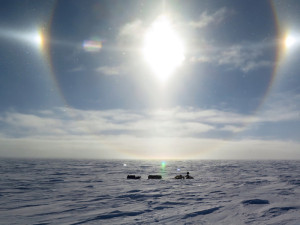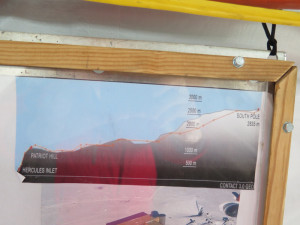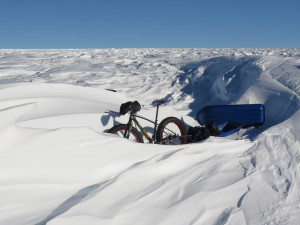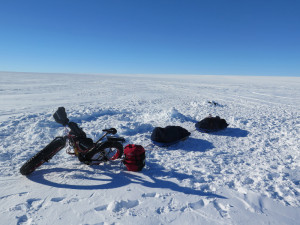By Jared Eborn

For some cyclists, the word ‘epic’ is thrown around to describe just about any ride – no matter how short or long – that was memorable.
Dan Burton has redefined the ‘epic’ bike ride.
“It’s not often you see something that has never been done before,” Burton, who coincidentally owns Epic Biking in Saratoga Springs, said. “So when you have an opportunity like this you kind of have to ask yourself ‘How can I not do it?’ “
Burton’s incredible ride was not just an adventure. It was the first time anyone has made a solo trip to the South Pole by bicycle and, as you might imagine, is not something one decides to do on a lark.
The trip took months of planning, hundreds of hours of training and a fair amount of throwing caution to the wind to pull off. But when Burton reached the South Pole and made history he said it was all worth it.
“This was an experience I just had to have when I started thinking about it.”
Burton’s journey didn’t start on the shores of Antarctica, of course. His road to the South Pole began behind the desk of a computer programmer with a pot belly and an unhealthy lifestyle.
“I thought I was going to die,” Burton said of his career and lifestyle switch. “Cycling saved my life.”
After getting laid off from his job as a programmer, Burton said he gambled his career on his new hobby and opened Epic Biking in the soon to be boomtown of Saratoga Springs. Along the way, he had a few customers ask about fat bikes but he admits to having initially dismissed the new trend.
“I never thought I’d get one in the store,” Burton said. “I didn’t think I’d ever sell one.”
His small rental fleet of two bikes led to a purchase of a personal fat bike and that led to occasional bike rides across a frozen Utah Lake. After learning about Eric Larsen – a Colorado-based explorer – making an attempt to ride to the South Pole during the winter of 2012-13, Burton became intrigued with the idea of doing something epic.
When Larsen ultimately abandoned his attempt, Burton said the wheels inside his head really started turning and he began planning his own journey to the bottom of the earth.
“When (Larsen) turned around and didn’t make it … I started looking into what it would take to do it,” Burton said. “I figured I had to do it this winter because if I didn’t, I knew somebody else would do it. I had a window of opportunity that I just had to take advantage of.”
Burton got in touch with Utah-based Adventure Network International and started working out the logistics of such an expedition. As one might expect, planning a bike ride to the South Pole is not quite the same as a stroll down the parkway or even a 100-mile group ride.
Months of planning – everything from researching the best kind of gear to use to what kind of food to pack – led to fundraising (including taking out a loan) to pay for it all and ultimately to the shores of the Hercules Inlet for a December 2 departure.
The plan was – at least as much as a plan to bike to the South Pole could be – relatively simple. Ride the bike as much as possible each day, push the bike when the conditions were unridable and drag a sled filled with supplies.
No problem, right?
Wrong.

The Antarctic landscape is unforgiving and relentlessly dangerous. The entire continent is covered, essentially, with a giant glacier – a sheet of ice that is in constant slow motion. That creates countless fissures and crevasses. Most are so small that they’re hardly noticeable. Others were wide enough – and deep enough – to threaten Burton’s life if he had a slight misstep or pedaled into the wrong place.
Constant vigilance was necessary to cover the roughly 750 miles safely.
Burton carried some essential safety gear. In addition to the arctic-grade clothing, tents and sleeping gear, Burton carried a satellite phone and a large supply of batteries. His most important piece of gear in many ways, he said, was a shovel used for a variety of reasons.
“I had outdoor camping stuff,” Burton said, “but nothing that would handle going to the South Pole. So I had to make sure everything I took was up to the task.”
Burton would peddle his Borealis fat bike for nearly 10 hours per day. He took an iPod and a few other electronic gadgets to keep his mind occupied and record data.
Though the entire journey could be described as dangerous, Burton said he was never scared and never considered giving up along the route.
Well, almost never scared.
“I never feared for my life, really” he said, “except for maybe one time when I fell into a crevasse.”

Burton was on foot, pushing the bike, at the time and misjudged a step. Before he knew what had happened his foot had slipped into a crack and he was hip deep in ice.
“Luckily it was not very wide, most of the crevasses are very small. I held onto the bike and was able to pull myself out. That was probably the time I was most scared and worried on the entire trip.”
Because there was no ‘night,’ Burton would set an alarm to let him know when it was time to hunker down for some rest. He took four full rest days – on Sundays – and a pair of half days to just let his body and mind recover from the grueling effort.
The satellite phone was used almost daily to touch base with his support crew at Hercules Inlet. If he didn’t call in every 48 hours, the crew would dispatch a plane to cover his course and find him – hopefully alive.
Luckily, that never happened. Instead, the planes that frequently travel back and forth from the pole to the various shoreline stations would drop off cache supplies. Food, batteries and other gear were left at designated spots and, using GPS tracking, Burton would ride from cache to cache to stay supplied, fueled and on the right course.
In what was an admitted mistake, Burton didn’t spread his supplies out in the best manner. He started out his trip with a diet consisting almost exclusively of Jelly Belly Sport Beans and Honey Stinger Waffles. His freeze-dried meals were delivered in his later cache drops.

That was not ideal – Burton said he craved the quick sugar based energy rushes later in the ride while his stomach and body would have loved some real food – even of the freeze-dried variety – during the early weeks.
As his legs tired, he chose to pedal out the final week or two with fewer supplies weighing down his sled. That was a mistake as he ran out of food towards the end.
“I had to call in and ask for more food with about two days to go,” Burton said. “They hopped on a snowmobile and came out to give me those supplies that I really needed to make the final push.”
At roughly 10 a.m. on January 21, Burton rolled up to the candy-striped pole marking the end of his journey.
A quick rest was followed by a quick trip back to base camp where he enjoyed a steak dinner and an enormous sense of pride and accomplishment.
“But what I really craved were some nice, warm, soft home-baked cookies,” he said.

As one might expect, Burton is already being asked if he’s going to do it again and try to beat his time.
For now, the polar expeditions are in the past.
“My expedition was not fun,” he said. “It was a challenge. By far the hardest thing I’ve ever done.
“If I were to do it again, there’s a lot of things I’d do differently,” Burton said. “But I think I’ll leave that for Eric Larsen or somebody else to do that.”






[…] the current record of the farthest bike ride in Antarctica out of the water. (That currently belongs to Daniel Burton, who rode 774.8 miles along the Hercules Route, with food drops, in […]
[…] — and blow the current Antarctic cycling record out of the water in the process. That currently belongs to Daniel P. Burton, who biked 1,247km between Hercules Inlet and the South Pole during […]
Comments are closed.